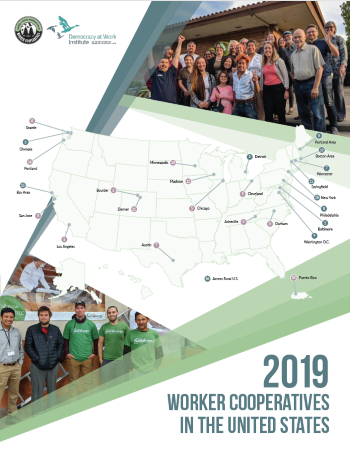New report from Democracy at Work Institute and U.S. Federation of Worker Cooperatives gives rich picture of state of sector
By Olga Prushinskaya

Every year since 2015 Democracy at Work Institute (DAWI) and the U.S. Federation of Worker Cooperatives (USFWC) have partnered to conduct an annual survey of worker cooperatives in the United States. The two organizations have just released the latest findings in the 2019 Worker Cooperative State of the Sector Report, analyzing data collected from 2018 and deepening collective understanding of the sector in several ways.
Launched as an attempt to simply count and track the growth of worker cooperatives, the annual census effort has grown to identify geographic clusters, entrepreneurial trends based on gender and racial identification, top-to-bottom wage disparity, and entry-level pay.
Worker cooperatives have grown in number of both enterprises and locations since 2015.
Thanks to the collection of this data, we’ve identified trends with significant implications for worker-owners, worker cooperative developers, and economic development professionals alike. We have demonstrated that worker cooperatives have grown in number of both enterprises and locations since 2015. We’ve been able to capture the impact of public support of worker ownership in cities like New York, which, with 58 worker cooperatives, now has the largest concentration in the country. We’ve shown the growing prevalence of traditional businesses converting to employee ownership to keep their businesses operating after an owner’s retirement or to restructure for growth. And we’ve illuminated the use of the worker ownership model by women and workers of color to access economic opportunities they have traditionally been left out of.

The 2019 Worker Cooperative State of the Sector Report highlights business size and growth over time, geographic and industry concentrations, compensation, demographic information on workers and worker-owners, and challenges faced by worker coops. At a moment of growing interest, increased investment, and policy gains in support of worker ownership, the survey provides a better understanding of worker cooperatives across the country. DAWI’s aim in sharing this data is to help cooperatives, developers, and advocates not only see the impact of their work but also make the case for deeper investment in sustained growth.
Key Data Points
- The survey verified 465 worker cooperatives. This is the largest number of worker cooperatives our annual census has verified to date. To be successfully verified, a business must: be incorporated, have at least three worker-owners, have at least 50 percent worker-ownership, and have completed a full year of business operation. Firms that do not meet these requirements are not included in the 465, and as such, we consider this to be a conservative count. Based on our work in the field and close partnerships across the country, we estimate the number of worker cooperatives operating at the time of the survey to be closer to 800 when non-verified enterprises are included in the count.
- Our count represents 35.7 percent net growth in verified worker cooperatives since 2013 and 5.1 percent growth in the net total number of verified enterprises from the previous year.
- The verified worker cooperatives employed 6,454 workers in 2018, producing about $505 million in revenue.
- Consistent with last year’s State of the Sector Report, participating workplaces reported an average top-to-bottom pay ratio of 2:1. This pay ratio is in stark contrast to the average pay ratio of traditionally structured businesses, which sits at 303:1. Worker cooperatives’ pay equity is a reflection of democratic workplaces prioritizing worker benefit from business success as opposed to shareholder or executive benefit form business success.
The number of start-ups has remained steady at 25 annually, while the number of business conversions has increased slightly.
Of the worker cooperatives surveyed, only 83 firms reported wage data. Among these firms, the average entry-level wage was $19.67, $7.00 above the state minimum wage in some areas with high concentrations of worker cooperatives. However, because of the small number of firms reporting, it is difficult to know if this is a meaningful number or noise in the data collected. This data point was last calculated two years ago, coming in at $15.82 per hour. Understanding this figure better in the future could be key to providing a promising look into how worker coops are improving the lives of workers and worker-owners in immediate ways.
This year’s report also includes a snapshot of how worker cooperatives are started (startup, business conversions), showing start-ups remaining steady at about 25 annually, but the number of conversions increasing slightly. And finally, for the first time, the survey attempted to identify shared challenges experience by cooperatives across the country, and found providing health care and other benefits was at the top of the list.
To help identify larger trends, DAWI and the USFWC will produce the State of the Sector on a biennial basis in the future.
DAWI and USFWC will walk through the data in greater detail during a webinar on February 19, 2020. Click here to register.
Olga Prushinskaya is a Metrics and Impact Analyst at Democracy at Work Institute. She works to understand and communicate impact in the growing field of democratic employee ownership. Learn more about Olga and DAWI’s work at www.institute.coop.
Julian McKinley, Senior Communications Director at Democracy at Work Institute, contributed to this piece.
To follow Employee Ownership News, subscribe to the Fifty by Fifty newsletter or follow us at Medium.
